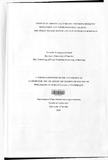| dc.description.abstract | This study determined entompathogenic nematode distribution, effects of abiotic factors and nematode
effectiveness on the sweet potato weevil Cylas puncticollis. A survey was conducted in the Rift Valley
region of Kenya and nematodes extracted from soils using Galleria mellonella as baits. Nematodes
occurred at 50-67% per agro ecological zone, 36% and 17% from farmlands and wild habitats
respectively with steinemematids being more frequent than heterorhabditids (9: 1). Nematode positive
sites in soils of <1, 1-2 and 2-3% carbon were 3%, 18% and 20% respectively (P<0.05) while
frequency in soils of pH 5-6, <4 and >7 was 25, 1 and 1% respectively. Recoveries of
entomopathogenic nematodes from the altitudes 2400-2600m and 2200-2400m were 17 and 4%
respectively, 75% from shores of lakes and dams and none from river banks and marshlands.
Steinernema yirgalemense, Steinernema weiseri, Steinernema karii, Heterorhabditis bacteriophora,
Heterorhabditis taysearae and a new Steinernema species were recovered from the region.
Steinernema karii was not responsive to soil texture when Galleria mortality and infectivity were used
to measure the effects but Heterorhabditis indica was most virulent in clay loam, moderate in sandy
clays and clay (80- 60) and least in sandy clay loam (40%)}. Heterorhabditis indica was more
infective in sandy clay and clay than in sandy clay loam and clay loam soils (40, 25, 17 and 7%
respectively). The highest and two lowest mean nematode establishments were significantly different
(P:S0.05). Survival of H. indica was 100% and that of S. yirgalemense 70% in sandy soils compared to
57 and 27% in clay for both nematodes respectively. Steinernema karii survived best in clay soils
(67%). The rate of survival was 22, 22 and 14% in the sand clay loam soil for H. indica, S. karii and S.
yirgalemense respectively. Sweet potato weevils survived better in sandy soils than in clay soils
(P:S0.05) in H. indica and S. karii treatments but at similar levels in S. yirgalemense treatments.
Galleria mortality increased significantly as soil pH increased from 4 to 7 (16 to 42% for both S. karii
and H. indica. Infectivity was 22 and 2-7% at pH 7.1 and pH 4-6.4 respectively for S. karii (P:S0.05)
but similar at all pH levels (3-6%) in H. indica. Percentage survival of S. karii was 24 and 20% at pH 4
and pH 6.4 respectively and that of H. indica was 23% at pH 6.4 and 6-11% at other levels of pH.
Steinernema karii and S. yirgalemense caused higher weevil mortality at pH 4-5.4 (>lweevil /plot)
than at pH 6.4«1/plot) but mean weevil mortalities were similar in H. indica treatments (>
1weevil/plot). Heterorhabditis indica reproduced more juveniles in weevils at pH 6.4 (24ij/larva) than
at pH S.4(4ij/larva) and S. yirgalemense at pH 4(S4ij/larva) than pH 6.4(0) while S. karii reproduced
poorly at all the levels of soil pH (3-4ij/larva).
In tests carried out for 12 weeks, nematodes lost virulence at S,IS and 2SoC in ash and mean survival
in ash was 18% for H. indica at SOC compared to S% of S. karii and 3% of S. yirgalemense.
Steinemema karii survival in sand was 3S% compared to 27 and 21% of H. indica and S. yirgalemense
at is-c and that of S. yirgalemense 30% compared to 21 and 2S% of H. indica and S. karii respectively
at 2SoC. The differences between the highest and lowest means were significant (P<O.OS). Percentage
survival of all nematodes in distilled water was 42-4S%.
Heterorhabditis indica was more productive in the s" silkworm larval instar (63,000 ij/larva) and S
yirgalemense in Galleria (80,400ij/larva) while S. karii was equally productive in both hosts (39,000-
43,OOOij/larva).Mean nematode yields at 100 and 200ij/larva doses were not significantly different.
Sweet potato weevil larval mortality was 76%, 70% and SO% in petri dish bioassays with H. indica, S.
yirgalemense and S. karii respectively and adult mortality was 12.S% in H. indica and S. yirgalemense
and 2S% in S. karii. Weevils at 0-10cm depths induced 7S-l00% vine damage and none if at >10cm.
Kakamega 4 was the most tolerant variety (47% infestation), KSP20 (66%) moderately tolerant and
KlO most susceptible (7S%). Steinernema carpocapsae (13% damage) was as effective as bifenthrin
(10%) and H. indica the most effective indigenous nematode (20% tuber infestation) compared to 40%
in the control treatments. Nematodes were most effective in cool moist weather when infestations
were moderate « 40%) while nematodes in infested Galleria cadavers were as effective as water
suspensions on sweet potato weevils.
The new findings from the study were that Steinernema weiseri, S. yirgalemense and Heterorhabditis
taysearae and a new Steinernema species are present in Kenya. The study also confirmed the presence
of S. karii and Heterorhabditis bacteriophora in the Rift Valley region of Kenya. Further the study
generated knowledge on effects of soil texture, soil pH, temperature and medium of storage on
entomopathogenic nematodes from a Kenyan perspective and also established that the fifth silkworm
larval instar is an efficient host for entomopathogenic nematode reproduction. The study also
demonstrated that indigenous entomopathogenic nematodes are comparable to pesticides for the
management of sweet potato weevils when application is well timed and their efficacy enhanced when
used together with appropriate insecticides and cultural practice. | en |

